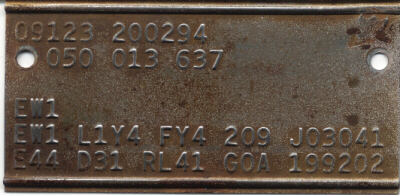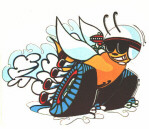This page will attempt to help Mopar owners document their cars. This is a BIG job and will take quite a while to complete. When we're done, you'll see that it isn't difficult to decode VINs, fender tags, broadcast sheets or build records.
We're going to cover the notion of a "numbers matching" car, what a fender tag is and how to read it, what a broadcast sheet is and where you might find one in your vehicle and lastly, how to obtain and decipher a build record.
First, let's discuss fender tags. The fender tag can be found on the driver's side inner fender on most models. Sometimes they will be attached to the radiator core support, cowl or A-pillar on older model cars. They are usually attached with machine screws or riveted in place.

Typical 1969-1980 fender tag.
Let's look at it line by line. You start by reading a fender tag from left to right, but from the bottom to the top:
E44 D34 LL41 G3R 374650
E44 is the engine option code. This is a 1973 fender tag (as we will see in a moment) and E44 in 1973 is a 318 2-bbl.
D34 is the transmission option code, which for 1973 is a 904 TorqueFlite automatic transmission.
The next three sequences are are the VIN of the car:
LL41 is a Dart four door sedan.
G3R means 318 engine, 1973 model year, assembled at Windsor, Ontario.
374650 is the sequential car number. Sequential numbers start at 100001 (the first car down that assembly line at the beginning of that model year). Some A-bodies in the early and mid '60s started at 500001.
The first thing to look at for a "numbers matching" car is to be sure the VIN on the fender tag matches the VIN on the dashboard. This is for 1969 and later cars. 1968 and earlier will have the VON (see below).
You can decode a 1966-1975 VIN in the search box at the top of this page.
HB1 A2B5 GB5 721 425106
HB1 is the body color, Light Blue. 1969 and later paint codes are three charachters, which indicate the first year the color was offered, the color, and the hue:
H = Model Year 1972
B = Blue
1 = Light Hue
Most, if not all, 1969 cars that are painted a 1969 color will have only a two-character paint code. For example, Hemi Orange was first offered in 1969 and it will be listed as V2 on the fender tag of a 1969 car. The same color on a 1970 car will be listed as EV2 to denote that it is a 1969 (E) color.
Model years from 1969 to 1975 are:
E 1969
F 1970
G 1971
H 1972
J 1973
K 1974
L 1975
A2B5 is the interior trim code, medium blue with vinyl bench seats. A2 means vinyl bench seats, which will be listed in a 1973 Factory Parts Book under Dart. B5 is medium blue, similar to the body paint codes, B=Blue, 5=Medium Hue.
GB5 is the color of the upper door frame (above the door panels). GB5 is medium blue, G=1972 was the year this paint color was first offered, B=Blue, 5=Medium Hue. Cars that don't have upper door frame paint, e.g. the door panel goes all the way up to the door glass, will have '000' in this location.
721 is the car's "birthday", or Scheduled Production Date. 721=July 21, 1973. The months are counted 1 through 9 (Jan to Sep) and A through C (Oct to Dec). Note that the Scheduled Production Date (SPD) is not necessarily the actual day the car was assembled. It was simply released for production on that day. It may actually have been assembled some time later.
425106 is the Vehicle Order Number (VON). This is an internal control number, the meaning of which has largely been lost to time. However, if a car was a special order of some type, the VON may reflect that fact. '70 and later special order cars usually have a letter in the first position of the VON, but not always. For example, all '70 AAR 'Cudas appear to have a VON that begins with M0, but '70 T/A Challengers do not. And I have one non-T/A Challenger in my database that has a VON that begins with M0. One day I'll compile a list of apparent VON descriptions.
HB1 U 22 B41 M85 R11
HB1 is the upper body color. On vinyl-top cars, you will see the vinyl top color here.
U means the car is built to USA specs. On '71 and later cars, this space will have one of three possible codes: U, USA specs.; C, Canadian specs; I, built for International export. '70 and earlier cars may have Y05, Y07, or Y09, which have the same meaning, respectively.
22 is a 22" radiator.
B41: This is where the optional equipment codes start.
B41 is power front disc brakes.
M85 is for bumper guards.
R11 is an AM radio.
I have been compiling lists of option codes and their meanings for each model year. When complete, I'll link it here. In the mean time, you can obtain a list of option codes by buying a "Models and Prices" guide, sometimes called a Salesman's Guide. You can get them through Automotive Literature dealers or you can get reproductions at many swap meets.
V5X END
V5 is body side moulding. X means the color is black.
END means "This is the end of the fender tag". If the tag says CTD, that means the options are continued on a second tag. On most (all?) Hamtramck cars, END will be listed as EN1 or EN2, depending on whether it was assembled on line 1 or line 2. But this isn't always the case, as we'll see soon.
Just by looking at the fender tag, we have a pretty good idea of what this car looks like.
Now let's look at a different tag:

Typical 1969-1980 Lynch Road fender tag.
We know from our previous decoding experience that we're looking at a 1970 Belvedere 4 door sedan, white, 318/904 with a light gold interior built on February 9, 1970. But notice the codes at the top of the tag:
09123 200294
These are the Gate Series and Line Sequence Numbers and information pertaining to them is here.
050 013 637
These are the old-style engine, axle and transmission codes. You can look them up in 1968 and older "Models and Prices" guides.
Note the complete lack of optional equipment. This is not uncommon for Lynch Road cars. It does not necessarily mean there were no options on this particular car, but that they are not listed on the fender tag. This is one reason why it's nice to find a Broadcast Sheet in your car. The Broadcast Sheet will list, or broadcast, every option the car came with.
Body Stampings
One way to detect a 'fake' car, or a car that been fraudulently put together to be sold as something it's not, is to verify the body stampings. On 1968 and earlier cars, the VON was stamped on the body in at least two places. Usually, this was stamped on the radiator core support and under the weatherstripping along the driver's side trunk extension. You will want to verify that the VON matches the VON on the fender tag. On 1969 and later cars, the last 8 digits of the VIN will be stamped in these locations. Almost always, the 1st and 2nd digits will be reversed. For example, a VIN of RS23U0E100001 will have 0E 100001 stamped on the body. Make sure this agrees with the fender tag and the VIN on the dash. Note that on E-bodies ('70-74 Barracudas and Challengers) and '71 and later B-bodies, the last 8 digits of the VIN will also be stamped on the driver's side firewall, just below the cowl (next to the plastic heater air intake).
If you look at a car on which these numbers do not match, it is advisable to carefully consider whether you wish to purchase it or not! No matter how pretty it is or how hot that Hemi is, you will have a heck of a time trying to sell it. In fact, if you know the car is bogus and you choose not to disclose this when you sell it, you could be held liable. If you see a bogus car, I recommend you write down the details and email me, consult your local Mopar club or contact one of the prominent Mopar magazines. Producing and dealing in bogus cars is fraudulent and illegal. It also hurts the hobby, so please don't take it lightly.
